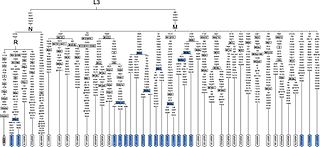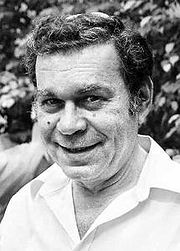
In biology, phylogenetics is the study of the evolutionary history and relationships among individuals or groups of organisms. These relationships are discovered through phylogenetic inference methods that evaluate observed heritable traits, such as DNA sequences or morphology under a model of evolution of these traits. The result of these analyses is a phylogeny —a diagrammatic hypothesis about the history of the evolutionary relationships of a group of organisms. The tips of a phylogenetic tree can be living organisms or fossils, and represent the 'end', or the present, in an evolutionary lineage. A phylogenetic tree can be rooted or unrooted. A rooted tree indicates the common ancestor, or ancestral lineage, of the tree. An unrooted tree makes no assumption about the ancestral line, and does not show the origin or "root" of the gene or organism in question. Phylogenetic analyses have become central to understanding biodiversity, evolution, ecology, and genomes.

Thought encompasses an "aim-oriented flow of ideas and associations that can lead to a reality-oriented conclusion". Although thinking is an activity of an existential value for humans, there is still no consensus as to how it is adequately defined or understood.

A cladogram is a diagram used in cladistics to show relations among organisms. A cladogram is not, however, an evolutionary tree because it does not show how ancestors are related to descendants, nor does it show how much they have changed; nevertheless, many evolutionary trees can be inferred from a single cladogram. A cladogram uses lines that branch off in different directions ending at a clade, a group of organisms with a last common ancestor. There are many shapes of cladograms but they all have lines that branch off from other lines. The lines can be traced back to where they branch off. These branching off points represent a hypothetical ancestor which can be inferred to exhibit the traits shared among the terminal taxa above it. This hypothetical ancestor might then provide clues about the order of evolution of various features, adaptation, and other evolutionary narratives about ancestors. Although traditionally such cladograms were generated largely on the basis of morphological characters, DNA and RNA sequencing data and computational phylogenetics are now very commonly used in the generation of cladograms, either on their own or in combination with morphology.
A heuristic technique, often called simply a heuristic, is any approach to problem solving or self-discovery that employs a practical method that is not guaranteed to be optimal, perfect or rational, but instead sufficient for reaching an immediate goal. Where finding an optimal solution is impossible or impractical, heuristic methods can be used to speed up the process of finding a satisfactory solution. Heuristics can be mental shortcuts that ease the cognitive load of making a decision. Examples that employ heuristics include using trial and error, a rule of thumb, an educated guess, an intuitive judgment, a guesstimate, profiling, or common sense.
Cognition is "the mental action or process of acquiring knowledge and understanding through thought, experience, and the senses". It encompasses many aspects of intellectual functions and processes such as attention, the formation of knowledge, memory and working memory, judgment and evaluation, reasoning and "computation", problem solving and decision making, comprehension and production of language. Cognitive processes use existing knowledge and generate new knowledge.
The theory of constraints (TOC) is a management paradigm that views any manageable system as being limited in achieving more of its goals by a very small number of constraints. There is always at least one constraint, and TOC uses a focusing process to identify the constraint and restructure the rest of the organization around it. TOC adopts the common idiom "a chain is no stronger than its weakest link". This means that processes, organizations, etc., are vulnerable because the weakest person or part can always damage or break them or at least adversely affect the outcome.
The thinking processes in Eliyahu M. Goldratt's theory of constraints are the five methods to enable the focused improvement of any cognitive system.

Machine learning (ML) is the scientific study of algorithms and statistical models that computer systems use to perform a specific task without using explicit instructions, relying on patterns and inference instead. It is seen as a subset of artificial intelligence. Machine learning algorithms build a mathematical model based on sample data, known as "training data", in order to make predictions or decisions without being explicitly programmed to perform the task. Machine learning algorithms are used in a wide variety of applications, such as email filtering and computer vision, where it is difficult or infeasible to develop a conventional algorithm for effectively performing the task.

Critical thinking is the analysis of facts to form a judgement. The subject is complex, and several different definitions exist, which generally include the rational, skeptical, unbiased analysis, or evaluation of factual evidence. Critical thinking is self-directed, self-disciplined, self-monitored, and self-corrective thinking. It presupposes assent to rigorous standards of excellence and mindful command of their use. It entails effective communication and problem-solving abilities as well as a commitment to overcome native egocentrism and sociocentrism.
Critique is a method of disciplined, systematic study of a written or oral discourse. Although critique is commonly understood as fault finding and negative judgment, it can also involve merit recognition, and in the philosophical tradition it also means a methodical practice of doubt. The contemporary sense of critique has been largely influenced by the Enlightenment critique of prejudice and authority, which championed the emancipation and autonomy from religious and political authorities.

Mathematical statistics is the application of probability theory, a branch of mathematics, to statistics, as opposed to techniques for collecting statistical data. Specific mathematical techniques which are used for this include mathematical analysis, linear algebra, stochastic analysis, differential equations, and measure theory.
Metacognition is "cognition about cognition", "thinking about thinking", "knowing about knowing", becoming "aware of one's awareness" and higher-order thinking skills. The term comes from the root word meta, meaning "beyond", or "on top of". Metacognition can take many forms; it includes knowledge about when and how to use particular strategies for learning or problem-solving. There are generally two components of metacognition: (1) knowledge about cognition and (2) regulation of cognition.
Futures techniques used in the multi-disciplinary field of futurology by futurists in Americas and Australasia, and futurology by futurologists in EU, include a diverse range of forecasting methods, including anticipatory thinking, backcasting, simulation, and visioning. Some of the anticipatory methods include, the delphi method, causal layered analysis, environmental scanning, morphological analysis, and scenario planning.

Mathematical sociology is the area of sociology that uses mathematics to construct social theories. Mathematical sociology aims to take sociological theory, which is strong in intuitive content but weak from a formal point of view, and to express it in formal terms. The benefits of this approach include increased clarity and the ability to use mathematics to derive implications of a theory that cannot be arrived at intuitively. In mathematical sociology, the preferred style is encapsulated in the phrase "constructing a mathematical model." This means making specified assumptions about some social phenomenon, expressing them in formal mathematics, and providing an empirical interpretation for the ideas. It also means deducing properties of the model and comparing these with relevant empirical data. Social network analysis is the best-known contribution of this subfield to sociology as a whole and to the scientific community at large. The models typically used in mathematical sociology allow sociologists to understand how predictable local interactions are and they are often able to elicit global patterns of social structure.
Undoing is a defense mechanism in which a person tries to cancel out or remove an unhealthy, destructive or otherwise threatening thought or action by engaging in contrary behavior. For example, after thinking about being violent with someone, one would then be overly nice or accommodating to them. It is one of several defense mechanisms proposed by the founder of psychoanalysis Sigmund Freud during his career, many of which were later developed further by his daughter Anna Freud. The German term "Ungeschehenmachen" was first used to describe this defense mechanism. When translated, it literally means "making un-happen", which is essentially the core of "undoing". Undoing refers to the phenomenon whereby a person tries to alter the past in some way to avoid or feign disappearance of an adversity or mishap.

The following outline is provided as an overview of and topical guide to thought (thinking):
Lajos Takács was a Hungarian mathematician, known for his contributions to probability theory and in particular, queueing theory. He wrote over two hundred scientific papers and six books.
Mathematical finance, also known as quantitative finance and financial mathematics, is a field of applied mathematics, concerned with mathematical modeling of financial markets. Generally, mathematical finance will derive and extend the mathematical or numerical models without necessarily establishing a link to financial theory, taking observed market prices as input. Mathematical consistency is required, not compatibility with economic theory. Thus, for example, while a financial economist might study the structural reasons why a company may have a certain share price, a financial mathematician may take the share price as a given, and attempt to use stochastic calculus to obtain the corresponding value of derivatives of the stock. The fundamental theorem of arbitrage-free pricing is one of the key theorems in mathematical finance, while the Black–Scholes equation and formula are amongst the key results.

Value tree analysis is a multi-criteria decision-making (MCDM) implement by which the decision-making attributes for each choice to come out with a preference for the decision makes are weighted. Usually, choices' attribute-specific values are aggregated into a complete method. Decision analysts (DAs) distinguished two types of utility. The preferences of value are made among alternatives when there is no uncertainty. Risk preferences solves the attitude of DM to risk taking under uncertainty. This learning package focuses on deterministic choices, namely value theory, and in particular a decision analysis tool called a value tree.









